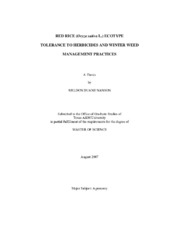| dc.description.abstract | Studies were conducted in 2004, 2005, and 2006 in south Texas to evaluate fall, winter, and spring weed control for commercial rice production, study tillage intensity and herbicide rate interactions for rice production, and determine the tolerance of red rice ecotypes from Texas rice fields using selected herbicides at varying rates. A single application of any herbicide or combination of herbicides was not adequate for weed control throughout the fall, winter, and spring. Fall applications of clomazone plus flumioxazin provided consistent weed control. Addition of flumioxazin to glyphosate provided excellent winter annual grass control with winter application. A residual herbicide, coupled with the proper contact herbicide is the key to extending control. In 2006, all tillage by herbicide treatments in all studies provided ≥ 90% control of all weed species. The conventional tillage treatment with low herbicide input provided the highest rice grain yield in 2005 and 2006, though they were not significantly different from the spring stale seedbed program with medium or high herbicide input in 2006. In 2006, fall stale seedbed treatments were among the lowest in yield. A stale seedbed program may be useful, but with substantial weed pressure, increasing the intensity of herbicide applications is necessary to overcome the absence of tillage. All rice ecotypes were adequately controlled by glyphosate and only one ecotype was found to be tolerant to 2x rates of both imazethapyr and imazamox. All ecotypes were adequately controlled by 2x rates of more than two of the four herbicides which included imazethapy, imazamox, glufosinate, and glyphosate. Ecotypes from the 3.2 group, genetically similar to the ecotype TX4, appear to be the most likely to exhibit tolerance to a given herbicide. Tolerance to glufosinate was found in 70% of the group 3.2 ecotypes. Sixty percent of ecotypes from group 3.1, genetically similar to Oryza rufipogon were not adequately controlled by glufosinate. | en |


